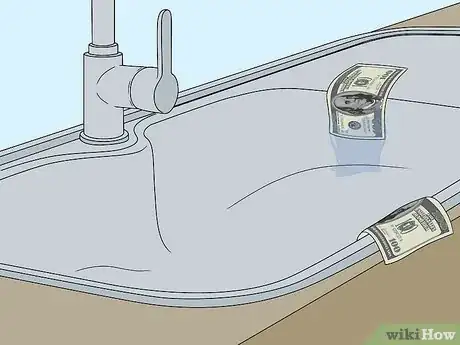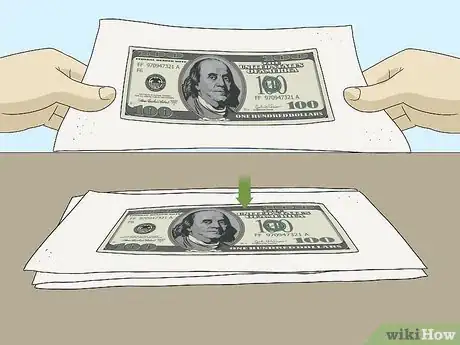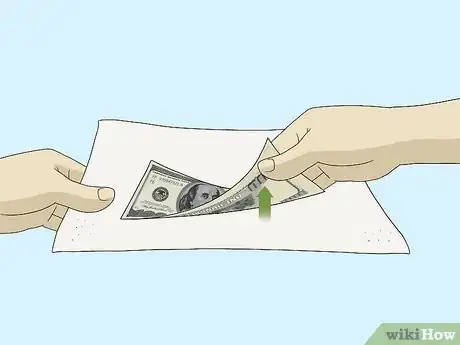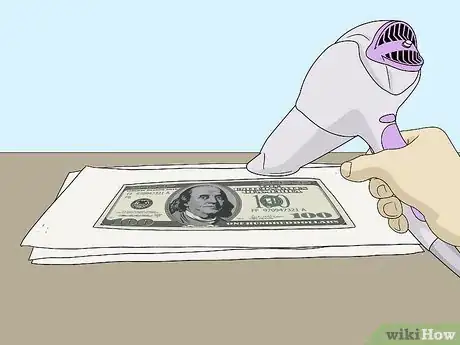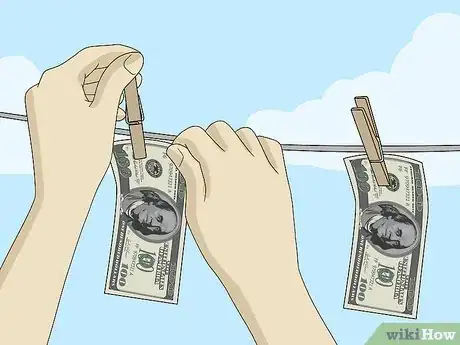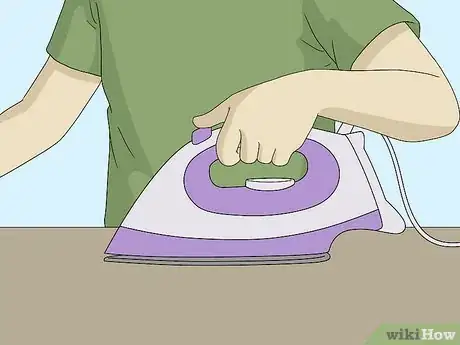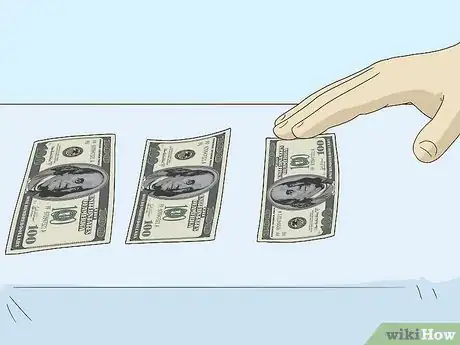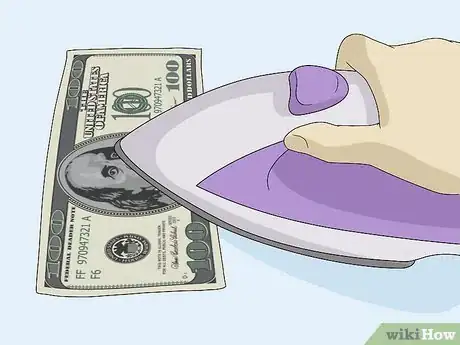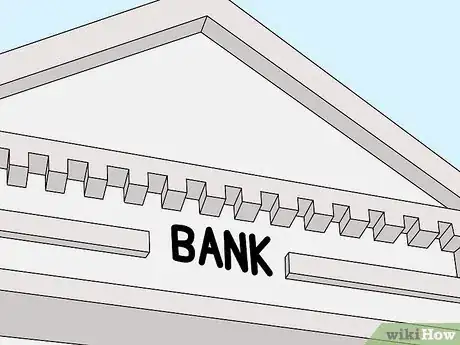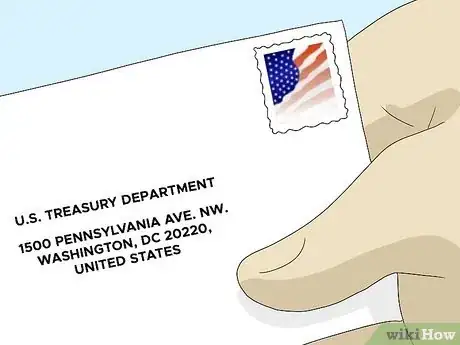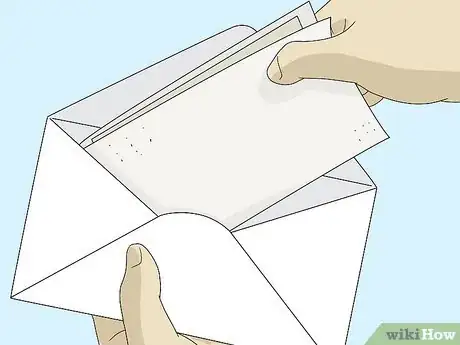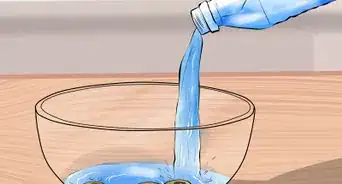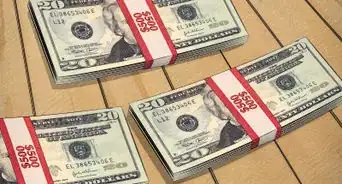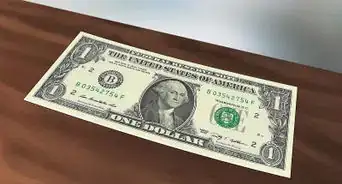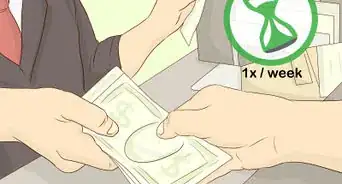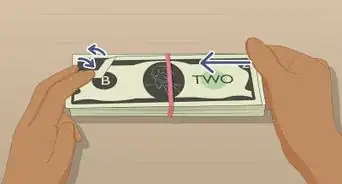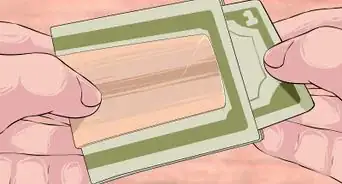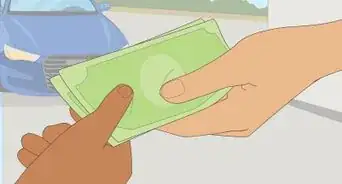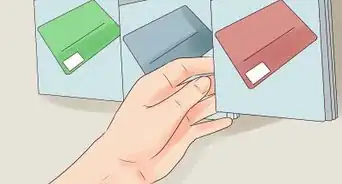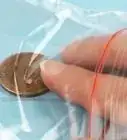This article was co-authored by wikiHow Staff. Our trained team of editors and researchers validate articles for accuracy and comprehensiveness. wikiHow's Content Management Team carefully monitors the work from our editorial staff to ensure that each article is backed by trusted research and meets our high quality standards.
This article has been viewed 105,200 times.
Learn more...
Whether you're caught in a rain storm or your bills got soaked in the washing machine, it's easy for money to get wet. Thankfully, all hope is not lost and your bills can easily be salvaged. With some time and creativity, you can save your money from a watery grave.
Steps
Drying with Air
-
1Find a dry space. Make sure the bills are kept in a room with good air circulation to lessen the time it takes for the bills to dry. Keep the bills in an area where they won't get blown away or easily lost. Avoid putting the bills near open air vents or next to tight crevices where the bills could fall. Try arranging them on the edge of a sink so the water will drip to the ground.
-
2Put a small to medium-sized box fan in the room. Place the fan at a good middle ground where the air won't blow the bills away while still drying them from a distance. Put the fan at a low wind speed to ensure your money won't fly off the table.Advertisement
-
3Arrange the bills in a neat stack. Place absorbent paper towels between every 5-6 bills to soak up the moisture. Change the paper towels when they become too saturated with the liquid.
-
4Turn the stack of bills over and over again every few minutes. This step is important to ensure both sides are adequately dry. Continue turning the bills over until they become crisp and dry again.
-
5Try a blow dryer. If you have some time, skip setting the fan up and blow dry the bills from above with a basic hairdryer. Again, make sure you're not setting the air speed too fast where the money is blown away. [1]
-
6Use the sun's warmth to dry out your bills. This often takes up more time than using a blow dryer or fan, but it requires the least amount of effort. Find a sunny spot like a windowsill or the dashboard of a car to ensure the bills are getting enough warmth.
- Close any windows and try to minimize air circulation so the bills aren't getting blown away.
- Divide the bills. In order to get each bill as dry as possible, you need to separate each one and arrange them next to each other in your sunny location.
- Leave the bills out for a few hours. The time varies based on how sunny it is and how soaked your bills are. In most cases, it only takes 2-4 hours for the sun's warmth to cause the water to evaporate from the monies, leaving them crisp and dry.
Ironing
-
1Consider using an iron to dry your bills. This method can be time consuming as you have to iron each bill one separately, but it's a time saver for those with just a few bills. Find a well-functioning iron with a sturdy ironing board. Make sure all the windows are closed and the fan is off so the bills don't blow away while ironing.
-
2Place each individual bill on the ironing board. Arrange as many as you can on the board, but you may need to iron them in separate sessions if you have a lot of wet currency. For those who want to add crispness as well, spray extra crisp heavy starch onto the bills.[2]
-
3Set the heating of the iron to the lowest setting. You may be tempted to set the iron temperature higher in order to dry the bill faster. However, this can lead the bills to become burnt or even set aflame in some instances. Take the time and make sure it's on the lowest heat setting so your bills are dried without becoming damaged.
-
4Iron each bill. Move the iron over the bill in a steady, back-and-forth motion. Never place the iron on the bill and wait. This will cause the bill to catch on fire or become burnt. Iron the bill back and forth, and then flip the bill over to iron the backside. Each bill should be dried in about 30 seconds, but it may take longer depending on the saturation.
Replacing Your Money
-
1Go to your local bank. Your bills may have become torn while wet, or the water damaged certain features on your money. Thankfully, your bank will replace those bills if they are merely damaged as opposed to mutilated. Damaged bills are those that retain at least 50 percent of its original form, and can be easily identified without any inspection from a currency specialist. [3]
-
2Send your money to the United States Treasury. If your money is water logged beyond all hope, there's still a chance its full value can be redeemed. The Bureau of Engraving and Printing (BEP) in the Department of Treasury accepts mutilated currency claims, which include wet money. However, there a few requirements that need to be met before placing a claim.[4]
- More than 50 percent of the bill must be able to be identifiable as U.S. currency by the BEP.
- If your wet bills have been severely ripped, the BEP may still accept them if you can provide enough supporting evidence that the missing portions have been destroyed.
- For those in the United Kingdom, The Bank of England offers a similar service for replacing damaged currency.
-
3Know how to properly send in your mutilated currency. It's easy for you to further damage your wet currency while you're sending it out. Find a sturdy envelope for your currency, and learn to take extra precautions when packing it.
- For wet bills that were rolled, never attempt to unroll or straighten them out.
- For bills that were straight when water damaged, don't roll them up or add any adhesive if the bills were ripped.
- Wet currency that's especially frail should be wrapped in cotton or plastic in order to preserve it as much as possible.
Community Q&A
-
QuestionI accidentally washed a pouch of $100 bills that I didn't realize I had in my pocket. I tried to iron them dry, and now they look like they are counterfeit. What do I do now?Take them to the bank and explain what happened. They can confirm they are legal tender and exchange them for you.
-
QuestionCan I put wet cash in a microwave oven?
 EricTop AnswererNo, do not put wet currency into a microwave oven, even on the lowest heat setting as the currency may catch fire or get burn marks.
EricTop AnswererNo, do not put wet currency into a microwave oven, even on the lowest heat setting as the currency may catch fire or get burn marks. -
QuestionCan I dry bills in a dryer set on low?
 Community AnswerNo, you could burn them beyond repair, even on the lowest setting. Try a hair dryer instead.
Community AnswerNo, you could burn them beyond repair, even on the lowest setting. Try a hair dryer instead.
Things You'll Need
-
Air method
- Dry area with good circulation
- Box fan or hair dryer
-
Sun dried method
- A flat surface next to the sun, such as a windowsill or car dashboard.
-
Ironing method
- Iron
- Ironing board
- Extra crisp heavy starch (optional)
Warnings
- If evaporated or ironed dry, folds will appear on the bills.⧼thumbs_response⧽
- Handle the wet bills with care as wet paper is very weak and can get torn quickly.⧼thumbs_response⧽
- Don't leave bills unattended for too long in places that aren't secure.⧼thumbs_response⧽
References
About This Article
To dry out wet currency, put your bills near a small to medium-sized box fan. Alternatively, you can use a hand blow dryer to save time. In either case, make sure to use a low air speed so you don’t blow your bills away. If you don’t have access to a fan or blow dryer, find a sunny spot like a windowsill or dashboard, and leave the bills in the sun for 2-4 hours. For more tips, like how to use an iron to dry your bills, read on!
